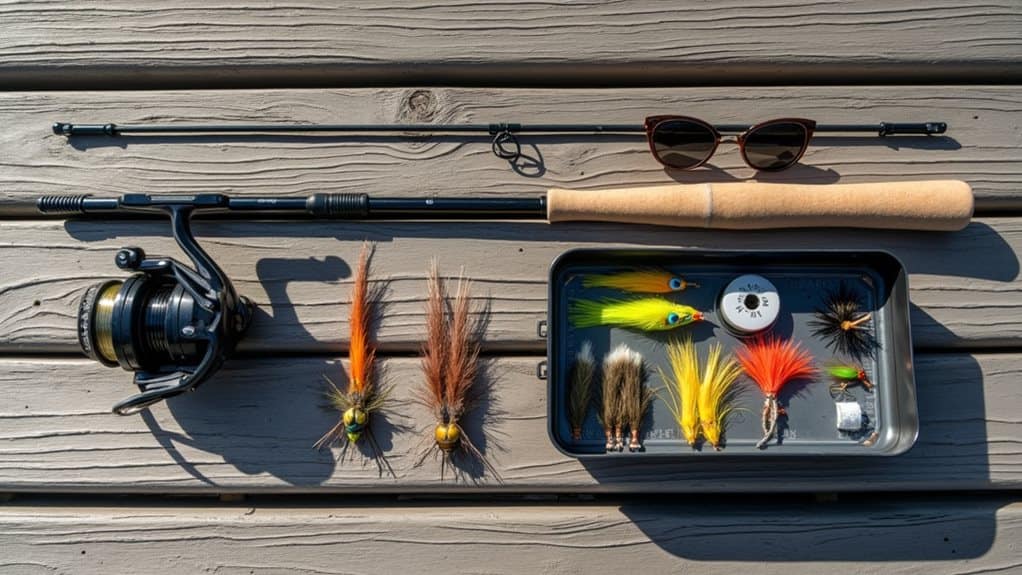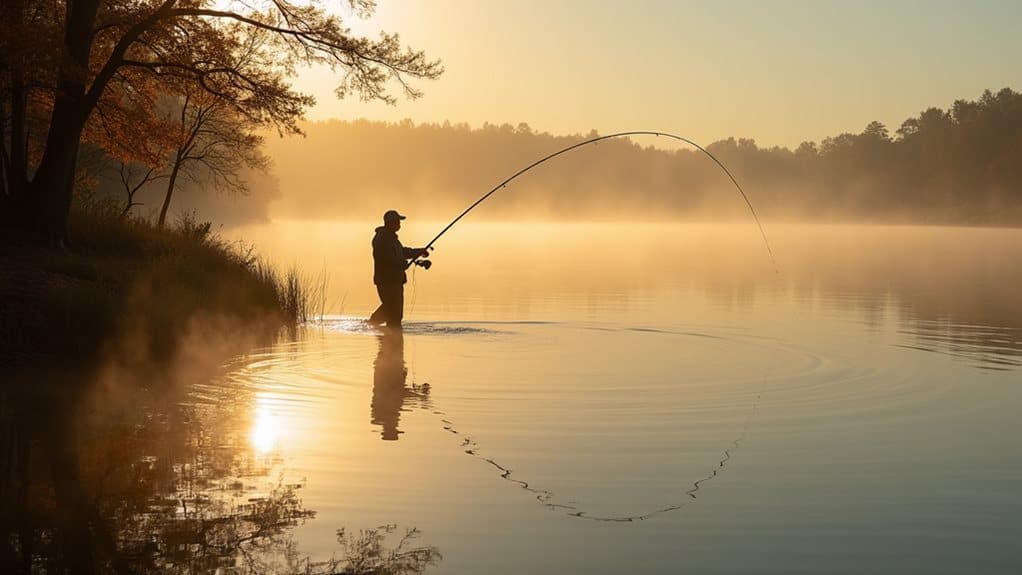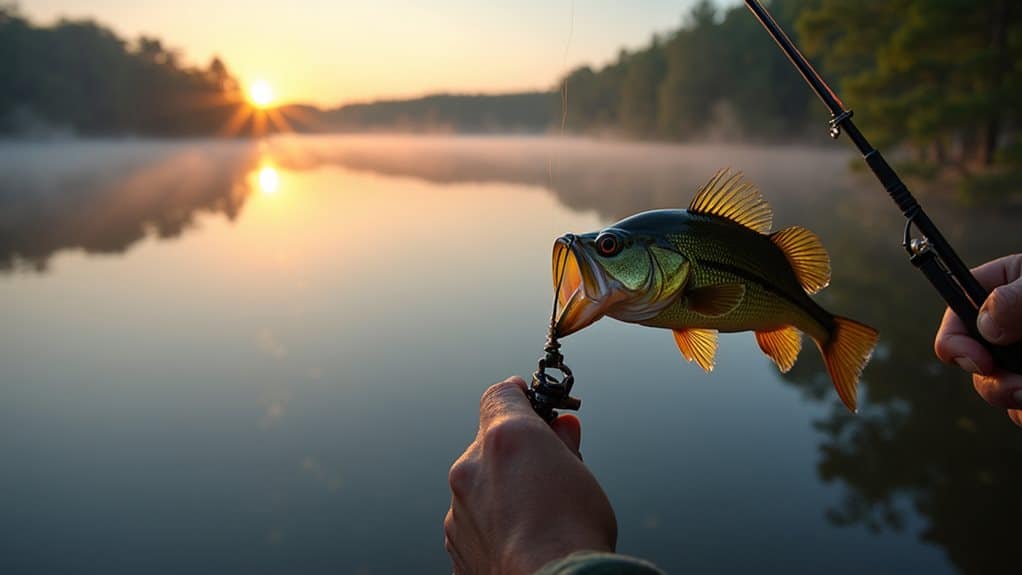To fly fish for bass with confidence, you’ll need a 7-weight rod for largemouth and 6-weight for smallmouth, paired with 12-pound tippet and proven patterns like Clouser Minnows or crawfish imitations. Focus on casting near structure like fallen trees and vegetation, using aggressive strips in murky water and subtle retrieves in clear conditions. Target shallow areas during spring and deeper waters in summer, adapting your approach to seasonal movements and local forage species for consistent success.
TLDR
- Use a 7-weight rod with matching line and 12-pound tippet for largemouth bass, or 6-weight for smallmouth bass.
- Master proven fly patterns like Clouser Minnow in chartreuse/white and crawfish imitations for consistent bass attraction.
- Adapt retrieval techniques to water clarity: subtle strips in clear water, aggressive erratic strips in murky conditions.
- Target structural elements like submerged vegetation, fallen trees, and adjust depth based on seasonal bass movements.
- Practice accurate casting near cover with rod tip low to maintain natural fly movement and avoid spooking fish.
Essential Gear and Equipment Setup for Bass Fly Fishing

The right gear can make the difference between a frustrating day on the water and successfully landing your first bass on a fly rod.
You’ll need a 7-weight rod for largemouth or 6-weight for smallmouth bass, paired with a matching fly line. Choose a 9-10 foot rod length, smooth drag reel, and 12-pound tippet for peak performance. When selecting your reel, prioritize drag reels for bass fishing since they provide the necessary stopping power to handle larger fish that might otherwise break free with a simple click and pawl system. Additionally, consider using a fish finder to locate fish and enhance your overall fishing experience.
Proven Fly Patterns That Trigger Bass Strikes
With your rod, reel, and line properly matched, success on the water depends heavily on selecting flies that bass can’t resist.
The Clouser Minnow stands as the most productive warmwater pattern, excelling in chartreuse and white. Combos designed for comprehensive capabilities allow for a more enjoyable fishing experience when targeting bass.
Lefty’s Deceiver mimics baitfish effectively, while crawfish patterns like Cohen’s Jiggy Craw work perfectly in cooler water when bass hold near bottom structure.
Large, dark leech patterns create a slithering action that proves irresistible in murky water or during temperature drops when bass become less aggressive.
Mastering Presentation Techniques for Different Water Conditions

Once you’ve selected the right fly pattern, your success hinges on how you present it to the bass.
Cast upstream and allow natural drift through the strike zone, using mends to prevent drag.
In clear water, employ slower, subtle retrieves to avoid spooking fish.
Murky conditions call for aggressive, erratic strips that trigger reaction strikes. Additionally, matching lure action to water temperature can significantly enhance your effectiveness when fishing.
Reading Bass Habitat and Seasonal Movement Patterns
Successfully targeting bass requires you to understand their preferred holding structures, which include submerged vegetation, fallen trees, rocky points, and depth variations that provide both cover and ambush opportunities.
You’ll need to time your fishing efforts around seasonal movement patterns, as bass migrate to shallow spawning areas in spring, seek deeper or shaded waters during summer heat, and concentrate in warmer depths throughout winter months.
Adapting your approach to current water conditions means recognizing how factors like temperature, vegetation density, and structural changes influence where bass position themselves and how aggressively they’ll respond to your flies. Additionally, targeting pre-spawn areas at 10-15 feet deep can significantly increase your chances of success.
Prime Holding Structures
Understanding prime holding structures represents the foundation of successful bass fly fishing, as these underwater and surface features dictate where bass position themselves throughout the year.
You’ll find bass concentrating around lily pads, weed beds, docks, fallen trees, and rocky shorelines.
These structures provide essential cover, ambush points, and access to forage while offering security from predators.
Seasonal Movement Timing
While prime holding structures reveal where bass position themselves, timing your approach around their seasonal movement patterns dramatically increases your success on the water.
You’ll find bass moving from deep winter havens to shallow staging areas when water temperatures climb from 55°F to 62°F.
These pre-spawn periods offer exceptional fly fishing opportunities as bass feed aggressively.
Water Condition Adaptations
As water conditions shift throughout the year, your ability to read and adapt to these changes determines whether you’ll consistently locate bass or spend hours casting to empty water.
Temperature drives bass metabolism and feeding activity, with warmer water requiring faster retrieves while colder conditions demand slower presentations for best results.
Building Skills Through Practice and Preparation
Success in fly fishing for bass doesn’t happen by accident—it’s built through deliberate practice and thorough preparation that mirrors real fishing conditions.
Practice with your exact gear setup, including the same leader length you’ll use on the water. Use visual markers on your fly line to improve distance control, and incorporate target practice by aiming at specific points.
Overcoming Common Bass Fly Fishing Obstacles

Even experienced anglers encounter predictable challenges when shifting to bass fly fishing, but understanding these common obstacles changes them into manageable stepping stones toward consistent success.
You’ll struggle with accurate casting near cover initially, but practice controlled line stripping with your rod tip low creates natural fly movement.
Avoid rod tip twitching, which produces slack line and missed strikes.
Adapting Your Approach to Local Bass Behavior
Success in bass fly fishing requires you to understand the specific behaviors and preferences of bass in your local waters, rather than relying on generic techniques.
You’ll need to study what forage species the bass are targeting, observe how they move and feed throughout different seasons, and experiment with retrieves that match the unique characteristics of your fishing location.
This targeted approach changes your fly fishing from guesswork into a strategic pursuit that consistently produces better results.
Study Local Forage Species
When you understand what bass are actually eating in your local waters, you’ll dramatically improve your fly selection and presentation techniques.
Bluegill dominate many bass diets, requiring sunfish-mimicking patterns in shallow, vegetated areas.
Thread-fin shad and golden shiners call for streamlined flies that imitate fast-moving baitfish.
Match your fly’s size, color, and movement to local forage species for consistent success.
Observe Seasonal Movement Patterns
Bass don’t stay in the same spots year-round, and understanding their seasonal movements will change your fly fishing success from hit-or-miss to consistently productive.
They’ll move shallow in spring for spawning, seek deeper water during summer heat, follow baitfish into coves during fall cooling, then retreat to stable depths in winter where they become less active.
Test Water-Specific Retrieves
While seasonal patterns tell you where to find bass, controlling water-specific retrieves determines whether they’ll actually strike your fly.
Start with slow, deliberate strips in cold water, then increase speed as temperatures rise.
Test different depths by counting down sink times, and mimic local prey like crayfish or baitfish through your retrieve patterns until you trigger consistent strikes.
Final Note
You’ve now got the foundation to approach bass fly fishing with genuine confidence. Remember, success comes from combining the right gear with proven patterns, honing your presentation techniques, and understanding where bass live throughout the seasons. Don’t let common obstacles discourage you—every experienced angler faced them. Keep practicing, stay adaptable to local conditions, and trust your growing instincts. You’re ready to consistently fool bass on the fly.




